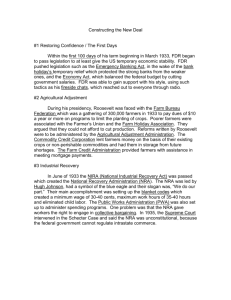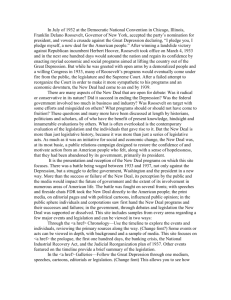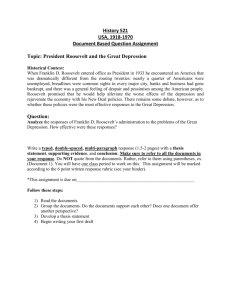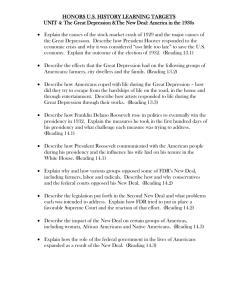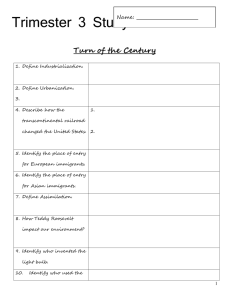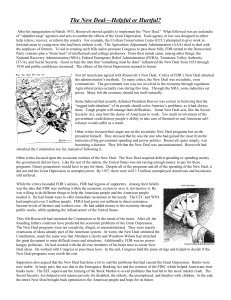David M - Franklin D. Roosevelt Presidential Library and Museum
advertisement
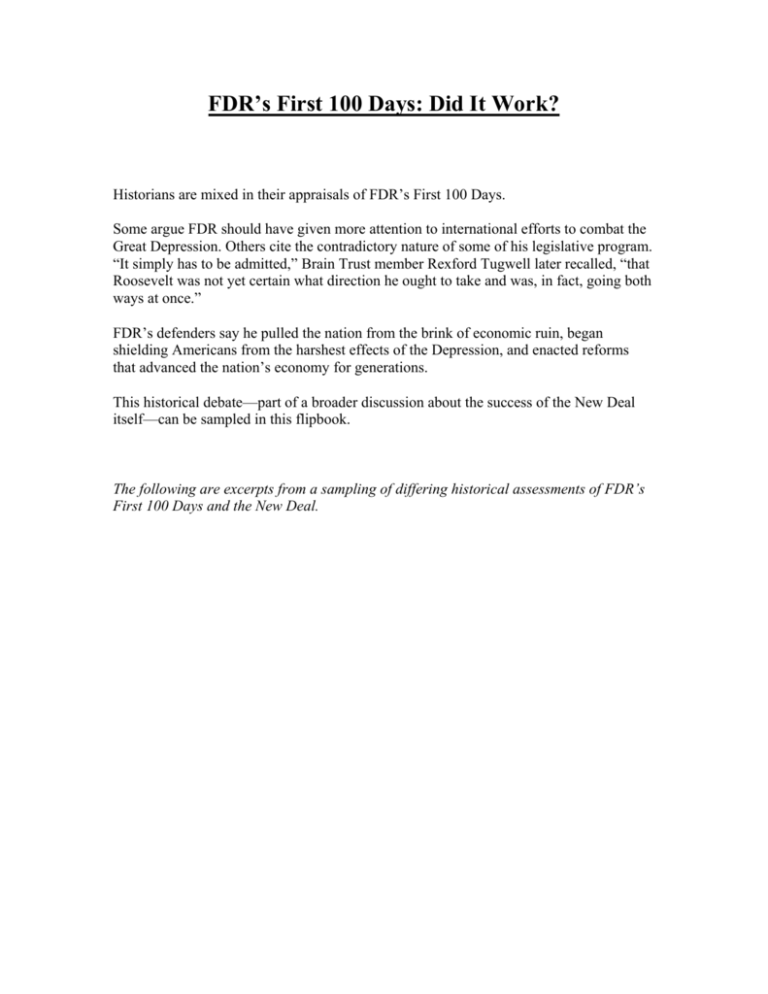
FDR’s First 100 Days: Did It Work? Historians are mixed in their appraisals of FDR’s First 100 Days. Some argue FDR should have given more attention to international efforts to combat the Great Depression. Others cite the contradictory nature of some of his legislative program. “It simply has to be admitted,” Brain Trust member Rexford Tugwell later recalled, “that Roosevelt was not yet certain what direction he ought to take and was, in fact, going both ways at once.” FDR’s defenders say he pulled the nation from the brink of economic ruin, began shielding Americans from the harshest effects of the Depression, and enacted reforms that advanced the nation’s economy for generations. This historical debate—part of a broader discussion about the success of the New Deal itself—can be sampled in this flipbook. The following are excerpts from a sampling of differing historical assessments of FDR’s First 100 Days and the New Deal. FDR’s First 100 Days David M. Kennedy, Freedom From Fear: The American People in Depression and War, 1929-1945 (New York: Oxford University Press, 1999), pages 153-154 “By any standard, the achievements of the Hundred Days were impressive. The New Deal had decisively halted the banking panic. It had invented wholly new institutions to restructure vast tracts of the nation’s economy, from banking to agriculture to industry to labor relations. It had authorized the biggest public works program in American history. It had earmarked billions of dollars for federal relief to the unemployed. It had designated the great Tennessee watershed as the site of an unprecedented experiment in comprehensive, planned regional development. No less important, the spirit of the country, so discouraged by four years of economic devastation, had been infused with Roosevelt’s own contagious optimism and hope. . . . But for all of the excitement about the Hundred Days . . . the Depression still hung darkly over the land. The precise battle plan of the New Deal’s attack on it remained difficult to define. Little coherent pattern could be detected in the unlikely mixture of policies that had been adopted. They ranged from orthodox budget cutting to expansive spending for relief and public works, from tough controls on Wall Street to government-supervised cartelization, from deliberate crop destruction to thoughtful conservation, from mortgage protection for the middle class to union protection for labor. . . . Some of these measures aimed at economic recovery, but at least as many were meant to provide only palliative relief or to enact reforms long-standing on somebody’s agenda but only obliquely related to combating the Depression. . . . About the only defensible statement that could be made about them in the aggregate was that they accurately reflected Roosevelt’s penchant for action, his inclination to experiment, and his receptivity to all kinds of innovation. Anthony Badger, FDR: The First Hundred Days (New York: Hill and Wang: 2008), p. 173-174. “Roosevelt gave indispensable assistance to many Americans in the summer of 1933. He instigated a regulatory regime for financial institutions that prevented a repeat of the Great Crash. He made a start on a massive program of investment in the physical infrastructure of the United States. What he had not found in 1933 was the magic key to economic recovery. But in the Hundred Days, Roosevelt demonstrated that a democracy need not be paralyzed in the face of economic catastrophe. He inspired a new generation of public servants for whom government service was an honorable, disinterested calling. They would enable the United States to survive the worst depression in the nation’s history with its democratic institutions intact and with enough social cohesion and government and productive capacity to fight a successful world war.” Robert S. McElvaine, The Great Depression: America, 1929-1941 (New York: Random House, 1984, 1993), p. 168-169. “The early New Deal made important changes in the American economic setup, but not drastic ones. Roosevelt tried to work within the existing power system, not to transform it. The Emergency Banking Act and the Glass-Steagall Act, despite the bankers’ complaints about deposit insurance, greatly strengthened the nation’s private banking system. The NRA allowed big business to protect their profits through ‘self-government.’ The AAA made payments to large landholders and, with Roosevelt’s blessing, rejected attempts to alter the rural power structure. The Home Owners’ Loan Corporation plainly helped many small homeowners, but this certainly was no attack on the system: it saved mortgage holders as well as homeowners. The federal relief effort, the CWA, PWA, and CCC were all decided departures, but none of them posed a serious threat to existing power relationships. The SEC was not liked by many on Wall Street, but they soon found that they could live with it comfortably enough. The TVA was perhaps the biggest ‘threat’ to the established order, in that it had the potential to demonstrate that planning and community cooperation could work and that a government-owned business could compete successfully with private enterprise. But to fault Roosevelt for missing his chance to bring about drastic changes in the American economic system is to overlook the restraints upon him (even assuming he wanted such changes, which in most cases he did not). A time of economic collapse, such as 1933, might seem just the time to introduce radical change. It is not. People may be willing to try new ideas; much evidence suggests that a majority was ready for bold new experiments in 1933. But any move toward either socialization or truly effective antitrust action would have been resisted vehemently by business. This would have made the economic collapse even worse in the short run (which might well not be very short). The fact is that, bad as things were in early 1933, they could get worse, and drastic change was likely to bring about that undesirable end. Roosevelt, to be sure, wanted no such fundamental alteration. He sought recovery and more limited reform. Two years after his election, he had failed to achieve enough of either, and pressures on him to move further to the left began to mount.” Anthony Badger, FDR: The First Hundred Days (New York: Hill and Wang: 2008), p. xv-xvi. “. . . [C]elebration of the Hundred Days and the subsequent New Deal has been challenged. Critics on the right, ranging from Herbert Hoover to economic historians of the 1980s and 1990s, have argued that Roosevelt artificially created a crisis in 1933, used the analogy of the wartime emergency, and foisted economic regimentation and government control onto the American people. For them, 1933 was a decisive wrong turn in American history, one that set the nation firmly on the road to collectivism and the creation of a Leviathan that is the modern insatiable, bureaucratic state. As a result, conservative critics argue, the commitment of both ordinary Americans and their leaders to individualism, the free market, and limited government suffered a blow from which the nation has never fully recovered.” National Recovery Administration (NRA): Anthony Badger, The New Deal: The Depression Years, 1933-1940 (Ivan R. Dee, 1989), 92-93. “Businessmen might still have accepted the NRA for all its dangers if the NRA had delivered economic recovery. But it did not yield the economic benefits that might have offset business’s alarms. The NRA only restored modest profitability to American business, if it restored any at all. Even in the sick industries like coal and textiles whose executives had been so enthusiastic about market stabilization and minimum prices, the NRA failed to deliver economic recovery. . . . What the NRA simply could not provide was an increase in total aggregate demand that might have put people back to work in significant numbers and dramatically increased business turnover and profitability. Businessmen were not prepared to trade off marginal improvement in economic stability for the potential hazards of bureaucratic control and intervention that the NRA represented.” Amity Schlaes, The Forgotten Man: A New History of the Great Depression (Harper Collins, 2007), 8. “Other new institutions, such as the National Recovery Administration did damage. The NRA’s mandate mistook macroeconomic problems for micro problems—it sought to solve the monetary challenge through price setting. NRA rules were so stringent they perversely hurt businesses. They frightened away capital, and they discouraged employers from hiring workers. Another problem was that laws like that which created the NRA—and Roosevelt signed a number of them—were so broad that no one knew how they would be interpreted. The resulting hesitation in itself arrested growth.” Arthur M. Schlesinger, Jr., The Age of Roosevelt: The Coming of the New Deal (Houghton Mifflin, 1958), 175-176. “ . . . [D]ismissal of NRA has become an historian’s and economist’s cliché. It is no doubt futile to suppose that this verdict can now be altered. Yet NRA was surely neither so rigid nor so ominous an undertaking as it has been conventionally depicted. Its ends— economic stabilization and social decency—were necessary and noble. Its assumption about the economy as more administered than self-regulating was much closer to actuality than the assumption of its critics. If it approached its goals in a clumsy and circuitous way, it did so because in 1933 the choice of roads was exceedingly limited. According to prevailing constitutional doctrine, the Congress lacked power to legislate directly on such matters as wages, hours, and collective bargaining. The choice was between tackling these things through the codes or not tackling them at all. With the descending spiral carrying all standards of work and wages into the pit of depression, the irresistible need was for action. By responding too eagerly to every aspect of that need, NRA accumulated for itself a mass of multifarious administrative responsibilities under which the organization eventually broke down. Still, NRA gave the American people for a fleeting moment a tremendous sense of national solidarity. So long as the sense of emergency gave the public interest a chance to win out over special interests, NRA worked. With a touch of recovery, the sense of emergency receded, and private interests came to the fore. . . . In the end, NRA foundered on the problem of asserting a vague public interest against the specific and well-focused demands of self-serving private interests. . . . And so, as the sense of crisis waned, so too did the psychological foundation for NRA. Yet the memory of solidarity remained; and the experience of solidarity prepared the nation for a greater and more arduous crisis, which, when it came, almost seemed an NRA reunion. . . . For all its defects, NRA represented an essential continuity which in face of crisis helped preserve American unity.” Jim Powell, FDR’s Folly: How Roosevelt and His New Deal Prolonged the Great Depression (Crown Forum, 2003), xi-xii. “The flagship of the New Deal was the National Industrial Recovery Act, which authorized cartel codes restricting output and fixing high prices for just about every conceivable business enterprise, much as medieval guild restrictions had restricted output and fixed prices. That FDR approved contraction was astounding, because the American people had suffered through three years of catastrophic contraction. With the National Industrial Recovery Act, it actually became a crime to increase output or cut prices—a forty-nine-year-old immigrant dry cleaner was jailed for charging 35 cents instead of 40 cents to press a pair of pants. This wasn’t full-scale government control as in the Soviet Union, but it came closer than anybody had thought possible. Although the NIRA was struck down by the Supreme Court in May 1935, the New Deal continued to multiply restrictions on business enterprise.” Agricultural Adjustment Administration (AAA) Anthony Badger, The New Deal: The Depression Years, 1933-1940 (Ivan R. Dee, 1989), 168. “For all the criticisms of farm recovery programmes, they represented a modest success. They doubled net farm income from $2 billion in 1932 to $4.6 billion in 1939. In 6 years the government made direct payments to farmers of over $4.5 billion. Yet in 1939 farm income was only 80 per cent of parity and farm income only reached 1929 levels twice before 1940. Nevertheless, the AAA enabled farmers to survive. The New Deal was essentially a holding operation for a large underemployed agricultural labour force. The farm programmes enabled that surplus labour force to stay on the land at a time when there was nowhere else to go. When urban prosperity created employment opportunities in the 1940s those surplus farmers could then move to the cities in relative security. “Farm recovery programmes also provided the policy tools with which farmers could be guaranteed security in the future. They changed the value system of farmers so that they could organize effectively to take advantage of government intervention. Above all, they removed much of the risk that made farming previously such a vulnerable occupation. . . .” Jim Powell, FDR’s Folly: How Roosevelt and His New Deal Prolonged the Great Depression (Crown Forum, 2003), xi. “ . . . FDR signed into law the Agricultural Adjustment Act, which led to the destruction of millions of acres of crops and millions of farm animals, while many Americans were hungry. New Deal agricultural policies provided subsidies based on a farmer’s acreage and output, which meant they mainly helped big farmers with the most acreage and output. The New Deal displaced poor sharecroppers and tenant farmers, a large number of whom were black. High farm foreclosure rates persisted during the New Deal, indicating that it did almost nothing for the poorest farmers. Historian Michael A. Bernstein went farther and made a case that New Deal agricultural policies ‘sacrificed the interests of the marginal and the unrecognized to the welfare of those with greater political and economic power.’” The New Deal Jim Powell, FDR’s Folly: How Roosevelt and His New Deal Prolonged the Great Depression (Crown Forum, 2003), 263-264. “ . . . [T]he New Deal did plenty to prolong high unemployment. New Deal policies were dubious when considered from the standpoint of their effects. After Americans had suffered through a catastrophic contraction for three years (1929-1933), FDR supported policies like the National Industrial Recovery Act that promoted further contraction. His executive orders helped enforce higher consumer prices when millions of Americans were unemployed and need bargains. FDR approved the destruction of food when people were hungry. FDR signed into law higher taxes for everybody, so consumers had less money to spend, and employers had less money with which to hire people—during the worst depression in American history.” Amity Schlaes, The Forgotten Man: A New History of the Great Depression (Harper Collins, 2007), 7-9. “ . . . [T]he deepest problem was the intervention, the lack of faith in the market place. Government management of the late 1920s and 1930s hurt the economy. Both Hoover and Roosevelt misstepped in a number of ways. . . . Roosevelt’s errors had a different quality but were equally devastating. He created regulatory, aid, and relief agencies based on the premise that recovery could be achieved only through a large military-style effort. Some of these were useful—the financial institutions he established upon entering office. Some were inspiring—the Civilian Conservation Corps, for example . . . . Other new institutions, such as the National Recovery Administration, did damage. . . .Where the private sector could help to bring the economy back—in the arena of utilities, for example—Roosevelt and his New Dealers often suppressed it . . . . [B]usinesses decided to wait Roosevelt out, hold onto their cash, and invest in future years. Yet Roosevelt retaliated by introducing a tax—the undistributed profits tax—to press the money out of them. Such forays prevented recovery and took the country into the depression within the Depression of 1937 and 1938 . . . One of the most famous Roosevelt phrases in history, almost as famous as ‘fear itself,’ was Roosevelt’s boast that he would promulgate ‘bold, persistent experimentation.’ But Roosevelt’s commitment to experimentation itself created fear. . . . The trouble, however, was not merely the new policies that were implemented but also the threat of additional, unknown, policies. Fear froze the economy, but that uncertainty itself might have a cost was something the young experimenters simply did not consider. . . . From 1929 to 1940, from Hoover to Roosevelt, government intervention helped to make the Depression Great. The period was not one of a moral battle between a force for good—the Roosevelt presidency—and forces for evil, those who opposed Roosevelt. It was a period of a power struggle between two sectors of the economy, both containing a mix of evil and virtue. The public sector and the private sector competed relentlessly for advantage.” Anthony Badger, The New Deal: The Depression Years, 1933-1940 (Ivan R. Dee, 1989), 301-312. “To lament the New Deal’s deficiencies or to celebrate its achievements has only limited utility. Instead, what it needed is an examination of the relationship between reforms instituted by the New Deal and the longer term developments of American society. . . . The New Deal was not static, it improved over time as deficiencies in existing programmes were exposed and new problems identified. Nowhere was this clearer than in its treatment of blacks. The ignorance of even sympathetic liberals like Eleanor Roosevelt mirrored at first the indifference with which the NRA and the AAA regarded blacks. Slowly she and others became aware that black problems could not be eradicated by generally targeting poverty. As a result of their perception of the special needs of blacks, agencies like the PWA, the WPA and the Farm Security Administration pursued racial policies that had changed significantly from the white preoccupations of 1933. . . . “Seen through the lens of [World War II], the New Deal’s overall function appears as a holding operation for American society: a series of measures that enabled the people to survive the Depression and to hold on until World War II opened up new opportunities. Industrial recovery programmes checked the deflationary spiral and yielded modest recovery that enabled businessmen to survive to enjoy dramatic war-time profits. Relief and welfare measures allowed the unemployed to struggle through until the war brought them jobs. Farm programmes enabled an underemployed labour force to stay on the land until the war created the urban demand which would absorb the surplus farm production and the industrial jobs which would absorb the surplus population. The plight of the poorest one third of the nation largely remained the New Deal’s unfinished business. . . . In the end, the New Deal was essentially a holding operation for American society because in the democratic, capitalist United States that was what most Americans wanted it to be.” William E. Leuchtenburg, Franklin D. Roosevelt and the New Deal, 1932-1940 (Harper & Row, 1963), 346-347. “The New Deal left many problems unresolved and even created some perplexing new ones. It never demonstrated that it could achieve prosperity in peacetime. . . . It enhanced the power of interest groups who claimed to speak for millions, but sometimes represented only a small minority. It did not evolve a way to protect people who had no such spokesmen, nor an acceptable method for disciplining the interest groups. . . . The New Deal achieved a more just society by recognizing groups which had been largely unrepresented—staple farmers, industrial workers, particular ethnic groups, and the intellectual-administrative class. Yet this was still a halfway revolution; it swelled the ranks of the bourgeoisie but left many Americans—sharecroppers, slum dwellers, most Negroes—outside the new equilibrium. Some of these omissions were to be promptly remedied. . . .Other shortcomings are understandable. The havoc that had been done before Roosevelt took office was so great that even the unprecedented measures of the New Deal did not suffice to repair the damage. Moreover, much was still to be learned, and it was during the Roosevelt years that the country was schooled in how to avert another major depression. . . . When recovery did come [during World War II], it was much more soundly based because of the adoption of the New Deal program.” David M. Kennedy, Freedom From Fear: The American People in Depression and War, 1929-1945 (New York: Oxford University Press, 1999), pages 376-378. “. . . [W]hat needs emphasis, in the final accounting, is not what the New Deal failed to do but how it managed to do so much in the uniquely malleable moment of the mid1930s. That brief span of years, it is now clear, constituted one of only a handful of episodes in American history when substantial and lasting social change has occurred— when the country was, in measurable degree, remade. . . . For all of his alleged inscrutability, Franklin Roosevelt’s social vision was clear enough. ‘We are going to make a country,’ he once said to Frances Perkins, ‘in which no one is left out.’ In that unadorned sentence Roosevelt spoke volumes about the New Deal’s lasting historical meaning. Like his rambling, comfortable, and unpretentious old home on the bluff above the Hudson River, Roosevelt’s New Deal was a welcoming mansion of many rooms, a place where millions of his fellow citizens could find at last a measure of the security that the patrician Roosevelts enjoyed as their birthright.” Jonathan Alter, The Defining Moment: FDR’s Hundred Days and the Triumph of Hope (Simon & Schuster, 2006), 332-333. “. . . [T]o argue that the shortcomings of the New Deal undermine FDR’s achievements reflects a narrow view. . . . The result of FDR’s efforts was a new social contract that has informally bound his successors to confront major domestic and international problems, rather than leave them entirely to the marketplace or to other nations. For all their antigovernmental rhetoric, even the most conservative of his successors, Ronald Reagan and George W. Bush, presided over an expansion of government and could never fully repeal the obligations FDR began redefining in 1933. The greatest of those obligations remains to the less fortunate, an idea that cleaves American politics to this day. ‘The test of our progress is not whether we add to the abundance of those who have much,’ FDR said in his second Inaugural Address, perhaps his clearest statement of principle in domestic affairs. ‘It is whether we provide enough for those who have too little.’ . . . . [W]hen hope was a dying ember, he succeeded brilliantly in restoring faith in democratic institutions and establishing a legacy of innovation.”


